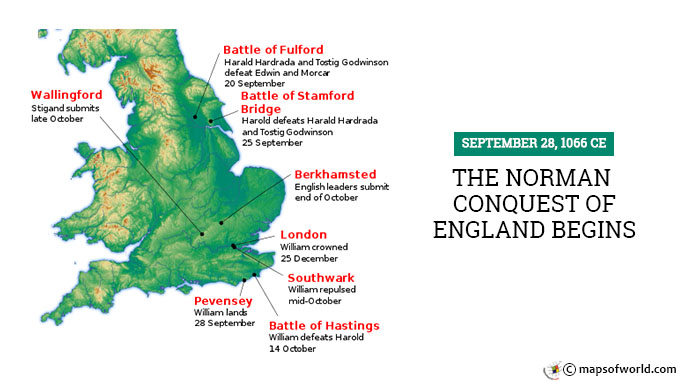In September 1066, the questionable title of King Harold II of England was under attack from all sides. With Harald Hardrada of Norway arriving in the northern countryside early in the month, he already had one adversary to contend with, but the arrival of Duke William II of Normandy on September 28th would ultimately prove to be his undoing. The French-speaking Normans, landing at Pevensey in Sussex, would have control of the country within weeks. The opportunity to seize the British Isles arose after Edward the Confessor, holder of the English crown since 1042, died with out an heir near the beginning of 1066. Having spent part of his youth in exile on the Norman coast, he built much of his court with people he trusted from across the Channel. Married to Edith of Wessex, Edward was soon feuding with his father-in-law, the wealthiest man in the country at the time, Earl Godwin. With no child to take over after Edward’s death, it seemed the right to take the throne fell to Harold Godwinson, the deceased king’s brother-in-law. Almost immediately after being crowned, King Harold II was under fire from others believing themselves to be rightful heirs. William II, Duke of Normandy, stated Edward had promised him the title with Harold’s permission. King Harald III of Norway — Harald Hardrada to most — cited an arrangement between his half-brother Magnus I and Edward’s predecessor King Harthacanute for the title. Both initiated preparations for war as soon as they could, gathering soldiers from the countryside and securing vessels to transport them to the English coast. Harald Hardrada landed first, joining forces with Harold’s brother Tostig for victory at Fulford on September 20th. Five days later, as William and his armies were nearing the point of launching their ships, Harold managed to overcome the Norse at Stamford Bridge, ending the threat from Harald Hardrada — the opposing king had been killed on the field. Turning to the south, Harold would have to retool his army and march to meet William in Sussex. Landing at Pevensey on September 28, 1066, William’s soldiers were itching for a fight. They had been ready to sail across the Channel six weeks before, yet William smartly held the invasion off while waiting for calmer seas and the English navy to be distracted by the Norse coming across the North Sea. When they set foot on English soil, the Normans went to work building fortifications from the surrounding forest at Hastings, using the castle as a staging area and secure outpost for raids into the countryside. Leaving a portion of his soldiers in the north to strengthen his hold on the territory, Harold spent a week in London resupplying the troops he brought with him before ordering the march to the southwest. Hoping to draw William out, the English dug in on Senlac Hill six miles from Hastings. On October 14th, the armies finally engaged for the first time. Though initially repelled by the English, the Normans soon maximized the advantage presented by their cavalry to sweep through the opposing lines and wreak havoc. Lasting all day, the carnage was brutal. The following morning, as Norman soldiers sifted through the enemy dead, they managed to locate Harold’s body and that of several brothers and nobles. Though offered a large sum of gold for the English king’s body by Gytha of Essex, Harold’s mother, William brushed off the plea and ordered Harold’s corpse thrown into the sea. Though they elevated Edgar Atheling to the throne, the English were not able to keep William at bay for long. Advancing toward London after his victory at Hastings, the Norman Duke forced the submission of the remaining English barons by the end of October at Berkhamsted. On December 25, 1066, King William was crowned in Westminster Abbey. Facing resistance from the English in the northern and western territories of modern Scotland and Wales, William rang the changes as he installed a new government. Women were soon allowed to remarry if widowed and, in the case of no heir, control their dead husband’s property. The most important change of all, arguably, is the institution of Old French as the official language of the ruling class. By abolishing Old English like that found in the epic poem Beowulf, William had inadvertently caused a shift reflected in the drastically different — and far more beautiful — writings of William Shakespeare. Also On This Day:551 BCE – Confucius, Chinese philosopher, is born 1238 – King James I of Aragon recaptures Valencia from the Moors 1787 – The United States Constitution is approved by Congress and sent to the states 1889 – The length of a meter is defined by the General Conference on Weights and Measures 1939 – Poland is divided between Germany and the Soviet Union after the Nazi invasion on September 3rd
September 28 1066 CE – The Norman Conquest of England Begins
In September 1066, the questionable title of King Harold II of England was under attack from all sides. With Harald Hardrada of Norway arriving in the northern countryside early in…
